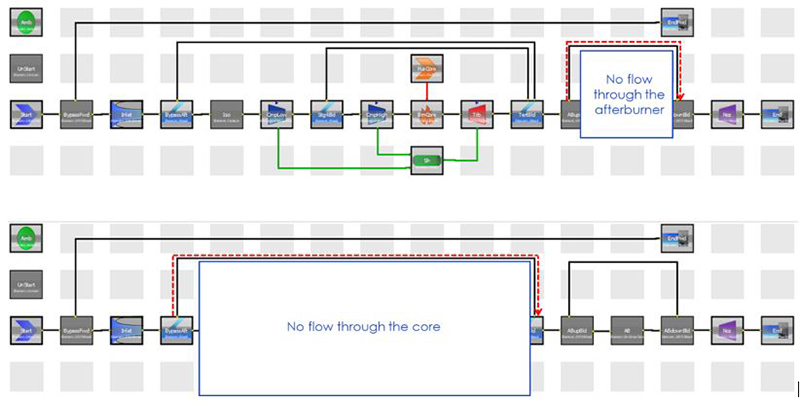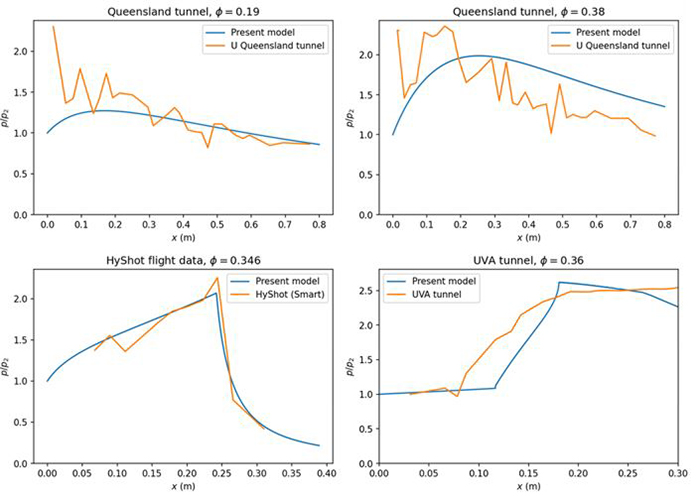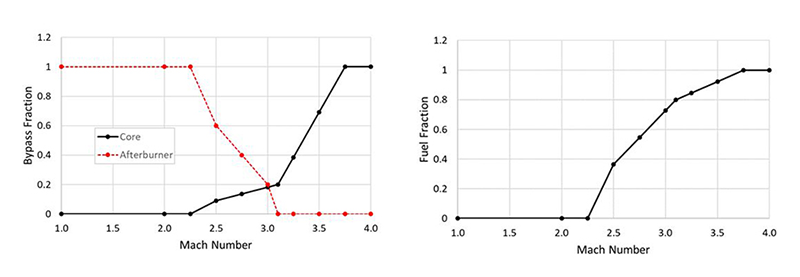Background
While hypersonics generally classifies speeds higher than Mach 5, the supersonic range is Mach 1 through Mach 5 where conventional turbojet engines can accelerate the aircraft from takeoff to a cruise near Mach 2. As the speed increases above Mach 1, compressible fluid dynamics become critical as shockwaves form at the engine inlet. A shockwave is a discontinuity that exists where the flow transitions from a high velocity to a high density. Because of the shockwaves, the air entering the engine is being compressed without the aid of the turbojet compressor. Therefore, the turbomachinery in the engine becomes inefficient and a new kind of propulsion engine is needed, a ramjet. The ramjet is a simple engine that uses the control of shockwaves to compress the incoming air and then decelerates the air to subsonic speeds for combustion before accelerating the flow at the engine discharge to develop thrust. Scramjets are another type of high-speed propulsion engine similar to a ramjet except that the flow is supersonic during combustion instead of subsonic for ramjet combustion.
In some cases, air-breathing engines are preferred because of their distinct advantages over rocket-propelled vehicles:
-
Air is the oxidizer, which reduces weight because it is not carried on the vehicle
-
Conventional takeoff and landing
-
Flexibility to operate at high speeds or low speeds throughout the mission
To achieve an aircraft design that can reach Mach 5 from takeoff requires consideration of differing engine and combustor configurations throughout the flight. Currently, there is no single tool to model a combined propulsion system as it transitions from subsonic to supersonic flow.
Approach
To successfully simulate the performance of a combined engine system, specifically a ramjet and turbojet, SwRI is using the Numerical Propulsion System Simulation (NPSS®) software. As a well-established tool in the aerospace industry, NPSS is used extensively for modeling aircraft with conventional turbomachinery. It is an object-oriented programming language that uses objects, or elements, to represent the components of thermodynamic processes, such as compression, combustion, and turbine power extraction. However, NPSS is fundamentally a thermodynamic flow network solver and has also been used to model supercritical carbon dioxide (sCO2) power cycles, refrigeration cycles, and liquid propulsion (rocket) cycles. Figure 1 shows the TBCC (Turbine Based Combined Cycle) model with illustrations showing the change in operating mode to either bypass the engine core or bypass the afterburner, depending on flight speed.

Figure 1: TBCC air-breathing model in NPSS showing bleed bypass around the afterburner (top) and bleed bypass around the core (bottom).
To simulate the propulsive performance of ramjets and TBCCs in NPSS, a few capabilities need to be developed. Specifically, these items include:
-
Inlet component
-
Isolator component
-
Combustor component
-
Nozzle component
-
Logic to determine if unstart phenomena occurs
-
Logic to transition from conventional propulsion using turbomachinery to ramjet propulsion
Accomplishments
This work completed the development of five components within NPSS that can be used to build a ramjet engine system. This work provides a new capability to model the engine systems of a TBCC resulting in a more informative engine model that can study the interaction between the engines, which is critical during transition periods of flight.
The inlet component was developed using efficiency correlations in the literature and then tuned to match data for an inlet similar to the SR-71 aircraft. The isolator component included criteria for determining unstart and the pressure rise based on length, both features available in the literature. The isolator was combined with the combustor element, which was successfully validated against ground and flight test experiments (Figure 2). The combustor is programmed as a Python executable that can predict the engine mode based on incoming flow conditions and can communicate that information with NPSS. An NPSS element has been written to control the model and allow it to function with the rest of the aircraft components. The thermal management system provides a unique approach to simplify control of the cooling technology for the engine simulation while still obtaining the cooling effects on the engine and the heating effects on the coolant, usually fuel.

Figure 2: The combustor model was validated with flight and ground-based experiments.
The components were implemented into a single engine model to simulate conditions from subsonic to supersonic flight. The transition from subsonic to supersonic flight required careful implementation of the inlet element, where an instability exists for inlet Mach numbers of one. This instability is expected because at lower Mach numbers, the inlet acts to accelerate the flow while at high Mach numbers the inlet acts to decelerate the flow. The transition from conventional engine combustion to the scramjet combustion was achieved through careful control of bleed air through the engine (Figure 3) and metering the fuel flow in both combustors (Figure 4). This project has successfully simulated a TBCC engine system using a single software, NPSS.

Future work is recommended to improve the implementation of components in NPSS. There are some improvements that could be made to improve convergence of the inlet element when operating at subsonic conditions, as well as re-writing the combustor code in C++ to avoid relying on the external Python script. Additional investigations could be done in the control of engine bleed flows and defining conditions for preferred transition to the scramjet combustor. The work completed has been focused on validation with the SR-71, which does not match modern implementations of supersonic aircraft. The modern approach has focused on fixed-inlet geometries and ramjet engine systems integrated with the vehicle body. A future study on a fixed inlet geometry of a modern TBCC is recommended to demonstrate the relevance of this work.

